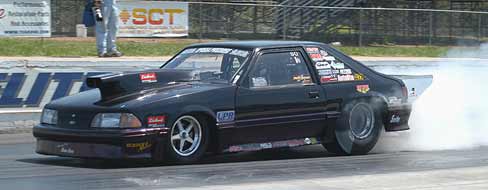| 

 But
is it particularly hard to find sponsors for something like
a Fun Ford or Super Chevy class, that may be very popular
within its niche but doesn’t get a great deal of widespread
attention in the overall drag racing scene? But
is it particularly hard to find sponsors for something like
a Fun Ford or Super Chevy class, that may be very popular
within its niche but doesn’t get a great deal of widespread
attention in the overall drag racing scene?
Glidden: I’ve never
even been to a street race in my life, in fact the fastest
street car I’ve ever had is that truck (gestures to
his tow rig), but I do know this much, once upon a time GM,
Chevrolet with its Trans Ams, Camaros, whatever, that was
the hot street vehicle. Those were the products that were
hot, but today it’s the Ford Mustang, so it’s
all these chip companies and after-market suspension makers,
those are the people right now that could benefit. And they
are to a certain degree; they’re here and in the [manufacturer’s]
midway. Ford Motor Company could actually benefit if they
maybe stepped up with a little bit of help for someone like
us, but they spend it with the sanction. So, as for strongly
searching for big sponsors, you just can’t get ‘em.
It’s tough enough to get [sponsorship] in NHRA. And
the problem that you have if you do find something that is
not really enough to offset what you’re doing—it’s
just enough to get by if you don’t really have a lot
of problems—is that if you run into a bad stretch where
it’s not really paying your bills; they still expect
you to keep going. And maybe we just couldn’t afford
to do that. Right now where we’re at, if we just decide
that it’s not the right thing to do, we just stay home.
Whereas, if you’ve got someone expecting you to be there;
you’re supposed to be there.
 Do you have any significant sponsorship right now?
Do you have any significant sponsorship right now?
Glidden: I’ve worked
with Edelbrock to design not just Ford racing parts, but racing
parts and to try to help maintain the industry standard with
what they’re doing. I’ve also got a few other
companies that help me out and I test with. In fact, I’m
running here tomorrow for a tire test for Mickey Thompson.
 Will
that be a 10-wide tire? Will
that be a 10-wide tire?
Glidden: Whatever they ask.
I’ve run radials on this car; I’ve run 27-inch
tires; I’ve run 33 by 17 tires, whatever they want.
I’ve raced this car since ’97, so I generally
can make pretty good guesses on what I need to do to make
valid data information runs with an itty-bitty tire or a great
big tire. A lot of time that also requires quite a bit of
time changing the car around to do that. The companies that
I’m involved with—even if I don’t personally
run what they’re selling—I’m still able
to see what they’re working with and what they’re
trying to improve.
 What
about your engine building? Is being out here important to
your own business? What
about your engine building? Is being out here important to
your own business?
Glidden: My business is
just myself and to charge for the amount of hours that I have
in it, you can’t do it. So, for the most part the customers
that I have right now, which are very limited, are, first
of all they’re all good friends, but they are also people
with cars that we can use new products on from many of these
companies that I’m working with.
 You’re
obviously a professional racer, but do you have much interest
in high-performance cars away from the track? You’re
obviously a professional racer, but do you have much interest
in high-performance cars away from the track?
Glidden: Not at all. Not
even not that much; not at all. You can bring old cars and
put them in front of me and I can’t tell you one thing
about their past, nothing. I know this one [his racecar] and
I know my customers’ cars.
|

